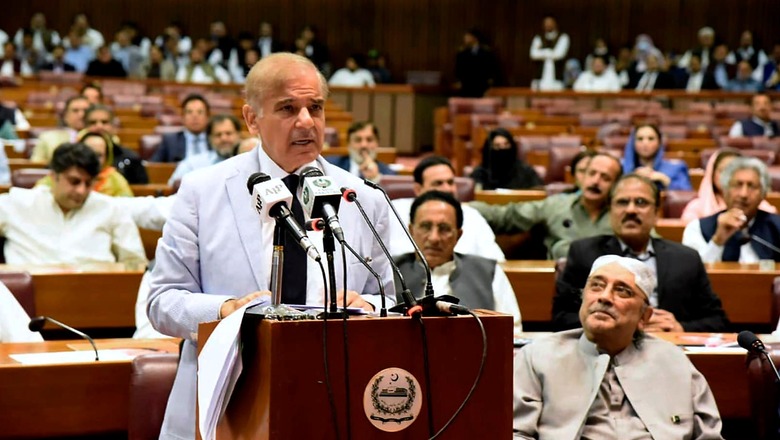
views
Is Pakistan going the Sri Lanka way? Broad macroeconomic indicators for both countries point to similarities in the economic outlook of the two nations on the sub-continent.
Mired in political crisis, Sri Lanka is facing massive external debt crisis as well. It took loans to speed up its infrastructure and energy sectors, but failed to get the return on investment. As per the Central Bank of Sri Lanka data, for its $51 billion external debt and liabilities, it has to pay around $4.5 billion annually till 2025 as debt servicing (principal + interest) from its foreign exchange reserve.
The island nation is also heavily import-dependent, with around 40% difference between import and export figures. It basically means the country needs additional sufficient foreign exchange reserves to ensure supply of essential items from abroad.
With increasing debt servicing each year, coupled with drop in big foreign currency earners, tourism and remittances, Sri Lanka has less than $2 billion in its foreign currency reserve. In May, the country had just $50 million of usable foreign currency reserve that was not enough even to arrange imports for a day. The rapid economic decline saw Sri Lanka defaulting on the external debt in May.
Pakistan is facing a similar crisis. The country has massive external debt of around $130 billion. In FY21, as per State Bank of Pakistan (SBP) figures, the country paid $13.424 billion in debt servicing. For the three fiscal quarters of 2022, the amount has already crossed $10.885 billion and is expected to reach over $14 billion.
Like Sri Lanka, Pakistan is also an import-dependent economy but to add to the problems, the export-import gap is huge and the condition becomes even more precarious when there is an imminent crisis on the foreign exchange reserve front. The country’s forex reserve has reduced to just around $9 billion, enough only for six to seven weeks of import.
In fiscal year 2021, as per the State Bank of Pakistan figures, the country’s export was worth $25.639 billion while import was much higher at $54.273 billion, a huge gap of almost $30 billion. For fiscal year 2022, it was even higher at $40 billion dollars, with imports at $72.048 billion and exports at $32.450 billon. In June 2022, the country’s imports were worth $7.038 billion against an export figure of $3.118 billion.
The next quarter is going to be crucial for the country with economic calculations stacked against it, particularly after the decision to lift the ban on non-essential and luxury items under pressure from some political elite and the importers’ lobby. Import figures may go up, adding pressure on declining foreign currency reserves.
The only solution to this problem will be taking up even more loans and the efforts to restructure the existing debt repayment options.
Pushan Dutt, Professor of Economics and Political Science at INSEAD, Singapore thinks that though the current economic crisis in Pakistan is really in a difficult shape, the country may avoid the fate of Sri Lanka, thanks to geopolitical reasons, India-China rivalry and Pakistan-China connect.
“While debt levels in absolute terms are same as Sri Lanka, Pakistan’s economy is larger, so debt to GDP ratio is smaller. At the same time, the country has a lot of foreign currency borrowing and we have seen instances of capital flight before. Now a lot of the debt is held by China so it may get debt relief due to geopolitical reasons,” he said.
Pakistan’s 2021 GDP, according to the World Bank dataset, is $339.4 billion in constant 2015 US$, almost four times higher than Sri Lanka’s GDP of $92.1 billion. Pakistan’s debt to GDP ratio is still under 100%. It was 84% in 2021, the corresponding data from Trading Economics says, while IMF analysis says Sri Lanka’s debt to GDP ratio reached 119% in 2021.
Support from Islamic Countries and China
Pakistan can also get support from other Islamic countries, says Jawad Nayyar, an economist, industrialist and techpreneur based in Pakistan, while emphasizing that the country will not go the Sri Lanka way. “Pakistan has certain geopolitical advantages that only a few others enjoy. These include cordial relationships with most of the MENA region, North Africa, and Asian and Far Eastern economies.”
Pakistan is the founding member of the Organization of Islamic Cooperation. The OIC has 57 countries as members spread across four continents. Pakistan being the second-largest state in the organization and, in fact, the only Islamic nation with nuclear power, can find support from within.
On May 1, Saudi Arabia agreed to bail out Pakistan with financial aid worth $8 billion. The oil facility (oil on deferred payment) from Saudi Arabia was doubled to $2.4 billion. Existing Saudi deposits worth $3 billion were rolled over to June 2023 and Pakistan is also expected to get additional deposits of over $2 billion.
On June 22, Pakistan signed a loan agreement with a Chinese consortium of banks for $2.3 billion. In addition to this, Beijing has already rolled over debt worth $7 billion so far to help Pakistan manage its economic crisis.
Pakistan is also expecting to get $1.2 billion from IMF in August from its bailout package. Pakistan army chief Gen Qamar Javed Bajwa, in fact, has requested the US to put pressure on IMF for early loan disbursal, says a report from Nikkei Asia. The country also expects that the IMF may unlock more funding with claims that it has met the terms set by the IMF to be eligible for further bailout assistance.
According to Mr Dutt, while things look bad for Pakistan, it won’t be as terrible as Sri Lanka where a standard currency crisis has morphed into political upheaval. Pakistan has a floating exchange rate so there will not be a sharp correction. But like Sri Lanka, it runs a large trade deficit which worsens as fuel prices spike and has borrowed in dollars. Inflation is spiking so overall fundamentals look bad.
Another Pakistani, now based in America, thinks otherwise. Dr Fida Mohammad, a professor of Sociology in the State University of New York, says Pakistan is in a debt trap and the Pakistani currency is losing value daily. According to him, Pakistan is more likely to default and, if things unfold similarly, will be bankrupt.
What Led Pakistan to This?
Dr Fida Mohammad’s reaction points to the global opinion about Pakistan that it is a military-run state with deep corruption and much of the economic damage is self-generated. “Yes, the whole country is destabilised. Military behind the scene controls everything, including the judiciary. The judiciary legitimises corruption of the deep state (military establishment). Socio-political chaos gives more political leverage to the military, and they are beneficiaries of the anarchy.”
Case in point is the move to lift the ban imposed on import of non-essential and luxury items even though the country is running short of foreign currency. The rush to create newer economic avenues through loans when the country is importing more than twice its exports also becomes a burden when its total reserve data has not gone beyond $20 billion in current US$ terms as per the World Bank dataset.
Pakistan’s external debt figure has doubled in the last 10 years. Its game-changer project, China Pakistan Economic Corridor (CPEC), a $62 billion infrastructure and energy roadmap, looks good on data but raises questions when we see that it is again being built on Chinese loans.
Corruption is also a deep bottleneck and it has not left even the CPEC projects, according to a report from a panel constituted by the Pakistan government. Pakistan crossed the 100th rank in 2004 on Corruption Perception Index of Transparency International and has seen consistent slide after that. It was at 140th position in the list of 180 countries in 2021. Higher the absolute number means a more corrupt state.
Nuclear Power the Only Saving Grace?
Pakistan is a nuclear power-capable country that may also come as a safeguard for it, says Jawad Nayyar. “Pakistan is a nuclear power and the world cannot afford a bankrupt Pakistan just because a few hundred million dollars of debt cannot be refinanced.”
Richard Gardner, CEO of Modulus, a US-based high performance enterprise for Fin-Tech solutions and AI, and a known financial analyst globally, says the nuclear power may finally come to save Pakistan from becoming the next economic default nation in Asia. “While Pakistan is, most certainly, in a perilous position, the country has a major advantage over Sri Lanka. The advantage, of course, is that it is an atomic power, and, until proven otherwise, I think we have to assume that the IMF and other international entities will take significant efforts to ensure the country doesn’t default on its debt.”
Pakistan’s former prime minister Imran Khan admitted in 2019 that his country still had around 30,000 to 40,000 terrorists and 40 terrorist groups operating within the borders and no country would want a nuclear-armed terrorist group in Pakistan in future. The question of the safety of nuclear arms becomes paramount in a politically destabilized Pakistan that further defaults on its economic debt.
Read all the Latest News and Breaking News here




















Comments
0 comment